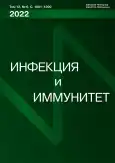Патоморфологические признаки острого респираторного дистресс-синдрома при конкурирующих заболеваниях легких: COVID-19 и саркоидоз
- Авторы: Воробьева О.В.1, Гималдинова Н.Е.1, Романова Л.П.1
-
Учреждения:
- ФГБОУ ВО Чувашский государственный университет имени И.Н. Ульянова
- Выпуск: Том 12, № 6 (2022)
- Страницы: 1191-1196
- Раздел: КРАТКИЕ СООБЩЕНИЯ
- URL: https://journal-vniispk.ru/2220-7619/article/view/119201
- DOI: https://doi.org/10.15789/2220-7619-PFO-1872
- ID: 119201
Цитировать
Полный текст
Аннотация
Пандемия COVID-19 является проблемой мирового масштаба. Клинический спектр инфицирования SARS-CoV-2 варьирует от бессимптомных или малосимптомных форм до таких состояний, как пневмония, острый респираторный дистресс-синдром (ОРДС) и полиорганная недостаточность. В статье приведено описание клинического случая инфицирования SARS-CoV-2 на фоне саркоидоза легких и сердечно-сосудистой патологии с развитием ОРДС и отека легких. Материалы и методы. Проведен анализ полученной сопроводительной медицинской документации (амбулаторная карта пациента, история болезни), клинико-морфологический анализ (описание макро- и микропрепаратов). Результаты. При гистологическом исследовании в легких выявлялись признаки диффузного альвеолярного повреждения в виде гиалиновых мембран, выстилающих и повторяющих контуры стенок альвеол. В стенках альвеол выявляются участки некроза, десквамация альвеолярного эпителия в виде разрозненных клеток или пластов, кровоизлияния и гемосидерофаги. В просвете альвеол определялся слущенный эпителий с геморрагическим компонентом, немногочисленные многоядерные клетки, макрофаги, белковые массы, скопление отечной жидкости. Легочные сосуды умеренно полнокровные, окружены периваскулярными инфильтратами. Выявлялись признаки саркоидоза легких. При гистологическом исследовании определялись эпителиоидно-клеточные гранулемы, состоящие из мононуклеарных фагоцитов и лимфоцитов, без признаков некроза. Определялись гранулемы с пролиферативным компонентом, с участками кровоизлияний. Выявлялись гигантские клетки с цитоплазматическими включениями — астероидные тельца и тельца Шаумана. В лимфатических узлах корней легких определялись неказеозные гранулемы, состоящие из скоплений эпителиоидных гистиоцитов и гигантских клеток Лангханса, окруженных лимфоцитами. В зонах периферических синусов лимфоузлов внутри гигантских клеток встречались тельца Хамазаки–Везенберга. В просвете бронхов обнаружен тотально слущенный эпителий, слизь. На слизистой оболочке, преимущественно субэндотелиально, определяются гранулемы, без казеозного некроза. При гистологическом исследовании сердца выявлялась фрагментация некоторых кардиомиоцитов, очаговая гипертрофия кардиомиоцитов с умеренным межуточным отеком, эритроцитарными сладжами, определялись зоны мелкоочагового склероза. Сосуды микроциркуляторного русла — малокровные, с гипертрофией стенок мелких артерий и артериол. При вирусологическом исследовании секционного материала в легких обнаружена РНК SARS-CoV-2. Заключение. Из данных медицинской документации и результатов патологоанатомического исследования следует, что причиной смерти больного Р.А., 50 лет стала новая коронавирусная инфекция COVID-19, вызвавшая двухстороннюю тотальную вирусную пневмонию. Наличие конкурирующих болезней, таких как саркоидоз легких и сердечно-сосудистые заболевания, усугубили течение болезни, привели к развитию раннего ОРДС и, в конечном итоге, к летальному исходу.
Ключевые слова
Полный текст
Открыть статью на сайте журналаОб авторах
О. В. Воробьева
ФГБОУ ВО Чувашский государственный университет имени И.Н. Ульянова
Email: olavorobeva@rambler.ru
ORCID iD: 0000-0003-3259-3691
к.м.н., доцент кафедры общей и клинической морфологии и судебной медицины
Россия, 428031, Чебоксары, Московский пр., 15Н. Е. Гималдинова
ФГБОУ ВО Чувашский государственный университет имени И.Н. Ульянова
Email: ngimaldinova@yandex.ru
ORCID iD: 0000-0003-2475-3392
к.м.н., доцент кафедры общей и клинической морфологии и судебной медицины
Россия, 428031, Чебоксары, Московский пр., 15Л. П. Романова
ФГБОУ ВО Чувашский государственный университет имени И.Н. Ульянова
Автор, ответственный за переписку.
Email: samung2008@yandex.ru
ORCID iD: 0000-0003-0556-8490
к.б.н., доцент кафедры дерматовенерологии с курсом гигиены
Россия, 428031, Чебоксары, Московский пр., 15Список литературы
- Визель А.А. Саркоидоз: монография. М.: Издательский холдинг «Атмосфера», 2010. 416 с. [Vizel A.A. Sarkoidosis: monography. Moscow: Atmosfera, 2010. 416 p. (In Russ.)]
- Визель А.А., Визель И.Ю., Шакирова Г.Р. Саркоидоз в период пандемии новой инфекции COVID-19 // Медицинский алфавит. 2020. Т. 1, № 19. С. 65–69. [Vizel A.A., Vizel I.Yu., Shakirova G.R. Sarcoidosis during COVID-19 new pandemic infection. Meditsinskii alfavit = Medical Alphabet, 2020, vol. 1, no. 19, pp. 65–69. (In Russ.)] doi: 10.33667/2078-5631-2020-19-65-69
- Воробьева О.В., Ласточкин А.В. Изменения в головном мозге, легких и сердце при COVID-19 на фоне цереброваскулярной патологии // Профилактическая медицина. 2020. Т. 23, № 7. С. 43–46. [Vorobeva O.V., Lastochkin A.V. Changes in the brain, lungs and heart with COVID-19 against the background of cerebrovascular pathology. Profilakticheskaya meditsina = The Russian Journal of Preventive Medicine, 2020, vol. 23, no. 7, pp. 43–46. (In Russ.)]
- Воробьева О.В., Ласточкин А.В. Острый инфаркт миокарда и коронавирусная инфекция (COVID-19) // Инфекционные болезни: новости, мнения, обучение. 2021. Т. 10, № 1 (36). С. 93–97. [Vorobeva O.V., Lastochkin A.V. Аcute myocardial infarction and coronavirus infection (COVID-19). Infektsionnye bolezni: novosti, mneniya, obuchenie = Infectious Diseases: News, Opinions, Education, 2021, vol. 10, no. 1 (36), pp. 93–97. (In Russ.)] doi: 10.33029/2305-3496-2021-10-1-93-97
- Kobak S. Catch the rainbow: prognostic factor of sarcoidosis. Lung India, 2020, vol. 37, no. 5, pp. 425–432. doi: 10.4103/lungindia.lungindia_380_19
- Loke W.S., Herbert C., Thomas P.S. Sarcoidosis: immunopathogenesis and immunological markers. Int. J. Chronic. Dis., 2013, vol. 2013: 928601. doi: 10.1155/2013/928601
- Patel N., Kalra R., Doshi R., Arora H., Bajaj N.S., Arora G., Arora P. Hospitalization rates, prevalence of cardiovascular manifestations, and outcomes associated with sarcoidosis in the United States. J. Am. Heart Assoc., 2018, vol. 7, iss. 2: e007844. doi: 10.1161/JAHA.117.007844
- Southern B.D. Patients with interstitial lung disease and pulmonary sarcoidosis are at high risk for severe illness related to COVID-19. Cleve Clin. J. Med., 2020. doi: 10.3949/ccjm.87a.ccc026
- Zhou F., Yu T., Du R., Fan G., Liu Y., Liu Z., Xiang J., Wang Y., Song B., Gu X., Guan L., Wei Y., Li H., Wu X., Xu J., Tu S., Zhang Y., Chen H., Cao B. Clinical course and risk factors for mortality of adult inpatients with COVID-19 in Wuhan, China: a retrospective cohort study. Lancet, 2020, vol. 395, no. 10229, pp. 1054–1062. doi: 10.1016/S0140-6736(20)30566-3
Дополнительные файлы







